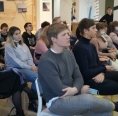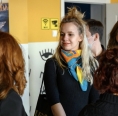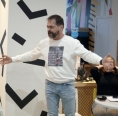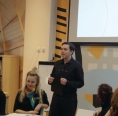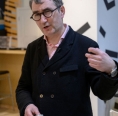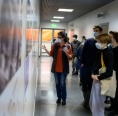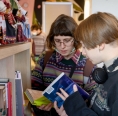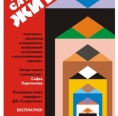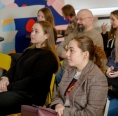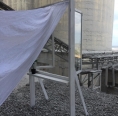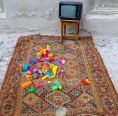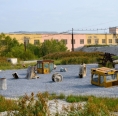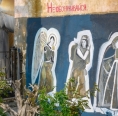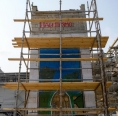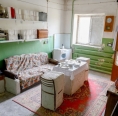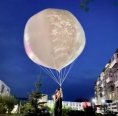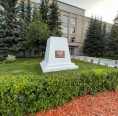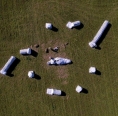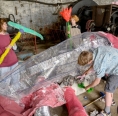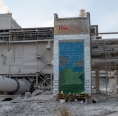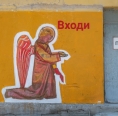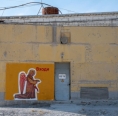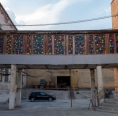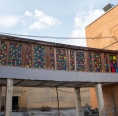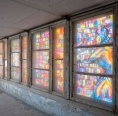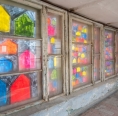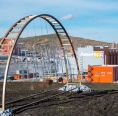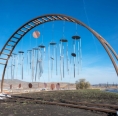-
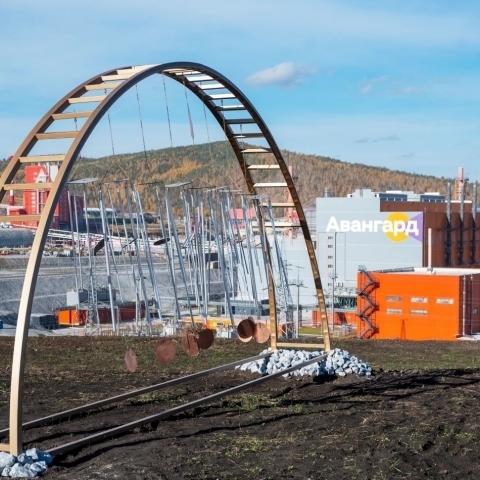
GITIS
Cooperation
-
Address:
-
Partners:
In 2020, the Sobranie Fund began cooperation with the Russian Institute of Theatre Arts – GITIS – the largest institute of theatre art in Russia and Europe.
Creative meetings, lectures, workshops, theater laboratories and presentation of new urban facilities are only part of the activities being implemented in Satka under the new agreement.
Experts, teachers and students of GITIS visit Satka with programs that reveal the creative potential of Satka residents, work with the urban environment and engaging theatrical practices.
The local school and college students attended the classes of the directors and teachers of the Institute of Theatre Arts Natalia Shurganova and Polina Zolotovitskaya. The participants of the theater laboratory “I want to say” learned to express their thoughts and feelings on stage as professional performers.
The representatives of the production faculty and the students of the experimental workshop of Kamenkovich-Krymov of the directing faculty of GITIS visited Satka to give public talks. In the summer of 2021, the students of the Kamenkovich-Krymov experimental workshop presented art objects created in the Satka district as part of the joint creative laboratory of the Sobranie Fund and the Russian Institute of Theatre Arts.
2020
"Glamor and Poverty of Theater World" was the name of the lecture of students of the Producer Department of the Russian Institute of Theatre Arts (GITIS), which took place on September 24 in Art-Satka, the creative public space.
The future producers told Satka citizens about the theater, how it works, what forms of theater exist, about the repertoire poster, how the performance is created, and why the theater needs a producer.
“Perhaps, now you are wondering why you need to know all this. For the audience, it is the end product that is really important, not who the founder or artistic director of the theater is. But an extremely complex mechanism is behind the flash of the performance. We are overwhelmed by these problems, we live with them. And we would like you to understand these peculiarities too,” Igor Ovchinnikov, the senior lecturer of the Department of Producer Business and Management of Performing Arts at GITIS, said.
The visit of GITIS representatives to Satka took place within the Producer Laboratory. For several days, the students and their professor were getting acquainted with the city and its citizens.
“Our task is to create theatrical or near-theatrical projects that could be implemented here in the future. Both conservative and modern. During these two and a half days, we saw so many things that it requires time to process them. It is too early to talk about anything specific. We will meet with the students, talk, write down and discuss some ideas. After all, we are producers, not just people with a vivid imagination. We need to make calculations. And we will get proposals for sure. We will look forward to a new visit to Satka, and I have to say we have not known about it before,” Igor Alexandrovich said.
Without a doubt, everyone who came to the meeting enriched their knowledge. Two students of the 11th grade, Leonid Puchkov (school No. 14) and Valentin Litvinov (school No. 5), also received a lot of tips on entering the university.
“We plan to enroll at the Producer Department of GITIS. It was so great to participate in this meeting. We had an opportunity to communicate with those who are studying to become producers and their professor. We received answers to all our questions, and now we are more self-confident. Most importantly, we realized that we were not mistaken in choosing our future profession. We are really interested in it,” Leonid concluded.
2021
Satka and GITIS, the largest Institute of Theatre Arts in Russia and Europe, expect new projects.
The Institute for the first time develops the practice of cooperation with a certain city and a region: as part of the working visit of its representatives to the Institute in Satka, which took place this week. GITIS, the Satka District Administration and "Sobranie" Fund entered into a three-party cooperation agreement. Commenting this a once-off experience, Grigory Zaslavskiy, rector of GITIS, theater historian, said:
“This all is for the first time. We have never entered into a cooperation agreement with a certain region. We work with universities, drama schools... But for the first time with a city. And we hold the Producer Laboratory in Satka for the first time. We’ve been longing to do this for a long time. And we got to implement this project here. Our cooperation began long before we entered into the agreement. We are absolutely sure that our first steps persuaded the city in our commitment and that our students, teachers, heads of the Institute are interested in activities in Satka. I mean that we checked each other, understood that we suit one another and today we signed the cooperation agreement. It seems right to me.”
In continuation of the conversation about joint projects and new plans, Grigory Anatolievich answered the questions of Magnezitovets Newspaper and Satka journalists.
“Grigory Anatolievich, as it is your first visit to Satka, tell us please how did you get to know it?”
“I saw a lot of wonderful books depicting Satka in all its beauty. Any facts of life differ from sugary photos in gift albums. But the industrial scale (edit: i.e. the Satka Magnezit Group production site) can’t be beaten up. I got the strongest impression when visiting the plant. This huge “pipe”, a furnace that spins, the modern workshop buildings, the robots, it’s amazing! Probably, the modern production should look like this. But I was glad to see it far enough from Moscow, Europe and industrial global centers. Lanterns in Proletarskiy avenue that change the city, it’s really fascinating. It’s all that I liked and maybe that I didn’t notice in the said albums.
On the one hand, there are amazing objects that have been preserved for years, like the Magnezit Cultural Center from the Soviet, Stalinist times. On the other hand, it’s a flexible, modern city that really doesn’t want its people to leave. The city that wants people to have reason to stay and think that here they can also live. It’s very important.”
“Industry and culture. How do you think they are integrated? Especially here in Satka, where culture and industry face each other in a line, that is the Magnezit Cultural Center and the Magnezit Plant?”
“The most important is that people managing industry understand that culture is an essential part of their lives and production. From industrial design, workshops decoration style to musicians and festivals held here, Satka has become a part of the Ural Industrial Biennale of Contemporary Art. Everything for the people to feel as part of the classical art. Unique projects with the Russian Museum took place when paintings were taken out of the museum space. That is impossible to believe in! As a person who ran exhibitions, I know what a museum piece given to the third party is. I know how everything is checked so that the paintings tour succeeds.
The manufacture itself becomes more modern, clear, the vacant space might become public, another area. Now “creative industry” is a modern phrase in Russia. And the city that parts with some of the industrial areas start thinking where people can employ and what can be done for it. It’s a modern approach inspiring respect. It’s also the case surprising you how someone can keep up with all modern ideas.”
“Is this the reason why GITIS comes to Satka?”
“Yes, of course. We want to follow trends.”
“Speaking about ideas and thoughts the group came to Satka with, did something turn on its ear after getting here?”
“I believe that such things occur only on the spot. As Dmitriy Olegovich Butkevich said, it’s “site-specific”. These are the projects that occur to you on site and are related to it like some comprehension of the spot.”
“Are you going to cooperate with local cultural workers?”
“We didn’t discuss certain projects but, for instance, I considered GITIS to manage the choreography studio. To set rotational shiftwork throughout the year, for example, when one young choreographer would come to teach for 3 months, another choreographer – for the next 3 months. And as a result, your students would get 4 different experiences, undergo 4 different training system. And in a year, there would be four different performance.”
-----------
Also, on February 3 in the Art-Satka creative public space, a creative meeting with the rector, teachers and students of the Kamenkovich-Krymov Workshop of the GITIS directing department was held. Representatives of the largest theater Institute of the country spoke about their class activities and demonstrated their projects.
2021
We are glad to announce great news and unveil the winner of the competition of student-led projects of the Production Department of GITIS! This is a 4th year student Sophia Kharitonova with her project of promenade-performance named “Living in Satka.”
This is a great result of the production laboratory work which was carried out last autumn.
6 proposals were submitted within the project competition of the Satkinsky District. The project by Sophia Kharitonova was selected for implementation. The author proposed to create a promenade-performance named “Living in Satka” and became a scholarship holder of the Sobranie Fund (Sophia will get a special scholarship till her graduation, and her project will be financially supported).
“Having visited Satka within the production laboratory in September last year, we all noted that the town seemed to be asking for a site-specific performance to be shown in it. While the form of audio promenade arose by itself. Today, this is a quite popular genre in Russia which is welcomed in the capital and in the regions,” says Sophia. “The main feature of the project is that it was made specifically for the people living in Satka, and creation of a similar one in any other town or city is outright impossible. I’m looking forward to starting work and hope that the performance will become a new visitor attraction of Satka! The play will be written specially for the performance inspired by true stories and memories of the Satka residents about the town. By combining them, we will not strive for being qualified as non-fiction, so fiction is quite acceptable for such a project. The performance is designed as light, life-asserting and heart-stirring,” says Sophia with confidence.
She already has a plan of action, an estimate, a storyline for the future play and an approximate route, as well as a draft of the play’s poster which is bearing elements of the mural by Agostino Iacurci on the facade of school No. 4 and published with the author’s permission obtained.
Congratulations to Sophia and thanks to the staff of the production department of GITIS for cooperation, arrangement and implementation of the production laboratory in Satka. Many thanks to all the students who proposed their initiatives for the Satkinsky District! All your projects are interesting and bright! We wish the winner good luck and look forward to the premiere of the “Living in Satka” play this summer!
2021
The Magnezit workers took part in acting master classes held online by professors of GITIS. Classes were held on the basis of Art-Satka, the creative public space, on March 17, 22 and 29.
The Institute rarely organizes such events for general public but they always demonstrate a high level of organization. It is not the first education project for Satka with GITIS: cooperation continues within a three-party agreement between the Theater Institute, the Satka District Administration and the Sobranie Fund.
The classes are held by experienced teachers, focusing on the audience and its needs. Topics for the Satka residents participating in the theater projects were chosen based on their stage experience and new development directions. Magnezit Group was represented by workers participating in the corporate project “To a Tee. The Carnival Night”.
Sergey Poselskiy, the senior lecturer of the Acting Department, held the first master class on “Emotion control”. The participants learned about emotional memory, the way to “pick” right emotion in a particular situation, to control their emotions and body, to get into “a negotiator character” and how an emotional contagion can affect achievement of a goal. Also, Sergey Nikolayevich shared some methods to secure against negative emotions of the people around us with the participants.
“I will be glad if everything we discussed today might be useful. I want you to feel the results from the today’s class. Use the skills learned and improve yourselves”, S. N. Poselsky said to the audience.
The next two events were dedicated to the topics “Body and Speech” and “Speech As the Basis of an Efficient Communication”. Viktoria Kosenko, the senior lecturer of the Scenic Speech Department, told the participants about body and voice interaction, gave advise how to relieve muscle tension and overcome stage fright, showed exercises for building vocal apparatus strength as well as traditional and non-traditional articulation exercises.
“GITIS professors’ master classes are useful not only for development of acting skills but for personality development in general. During the lecture held by Sergey Nikolayevich we learned how important it is to be able to recognize personal and other people’s worldview paradigms based on the book “The 7 Habits of Highly Effective People” by Stephen Covey. Thanks to that book I was able to understand the terms “the personality ethics” and “the character ethics”. And confirm once more that clear path to success promoted by open information sources might be inaccurate. The skills of concentrating on the object during the performance and stress coping before a significant event were also useful. The next series of classes demonstrated the variety of techniques to develop the speech apparatus, which, like the body, should be trained daily. I will consider a lot of materials shown as a guideline to follow. The more you dive into the performance art, the more you realize that the sky is the limit. And that any skills demonstrated on the stage are the result of hard, self-organized work. I want to thank the masters for knowledge and literature offered for the further development,” Maria Dodina, leading specialist of External Communications Department, said.
“Master classes were prepared by the experts. The topics were actual and highly-demanded. We communicate with people every day at work and in our free time. It is very important to present the information clearly and properly, so that the desired effect is achieved and the intended goal is implemented. Master classes are also useful for creative potential development. I appear on the stage at least once a year. In the future, I would like to participate in master classes on stage movement, facial expressions,” adds Yuri Shumkov, head of the “Veteran” workshop.
By the way, the Magnezit workers will soon be able to put the lessons into practice: young people are discussing a new theater project dedicated to Victory Day, which we will soon tell you about.
2021
Students of experimental workshop of Kamenkovich-Krymov of the Director’s School in the Russian University of Theatre Arts presented objects of art created in the Satka region as part of the joint artistic laboratory of the Sobranie Fund and Russian University of Theatre Arts (GITIS) to the Satka residents. The presentation was held in the Magnezit Museum on August 10.
The projects for artistic improvement of Satka were created by the stage designers and painters under supervision of their teachers: painter Irina Korina and art critic Dmitry Butkevich. The students got their inspiration during the first visit to the town in February of this year. During their next visit the students realized their ideas. As a result the district gained 8 new objects of art which will become a part of the route planned for Ural Industrial Biennale of Modern Art (the route to Satka is considered to be one of the most popular ones, the free tickets for August have long run out, and the closest one can get are only for September).
One of the first to finish their project is Marusia Pavlola, who presented Mile Balloons. Three white balloons filled with helium were placed in several places around the town symbolically connected with ending of life or endings of other processes. The fists one is at the start of Solnechnaya Street, at the place where the old cemetery was located prior to construction. The second one is near the monument of the Sickle and the Hammer, which symbolizes the passing era of 90s privatization. The third one is in the area of the Karaguy Pit, which means the running out of resources.
“The project turned out to be beautiful but intangible. The evening we finished setting up the balloons they were blown away by a hurricane”, noted Dmitry Butkevich.
At the same time as the Mile Balloons an Explosion Monument was installed near the Magnezit Group office building. It is a plywood structure shaped as a pyramid, every day at 16.00 it produces a plume of smoke (at this time the rocks are blown up in the Karaguy Pit).
“The geography of Satka constantly changes. New pits appear and the old ones close. After some time surface production of magnesium carbonate will be given up as well. But we must remember it, remember the pit explosions and the generations who bore witness to all of that”, believes the project’s author, Martyn Stepanov.
Two projects introduce mythology to the spaces: The turbine building of the Porozhskaya HPP, and a place near the turn to Magnitka village from M-5 highway. Their authors, Peter Voznesensky, Arina Kleparskaya and Varvara Baboshina, tried to imagine what once have been and what will happen in the future.
“After our first visit to Satka we understood that the topics most exciting for us are connected to the history of the town. The duration, unpredictable future and mysterious flow of this history. We were worried about condition of the monuments and their safety. How is Satka’s history recorded? Which facts are true, and which are false? What can be done about the missing information? Who knows, there just might have been some ancient Greek explorers visiting Satka”, said Varvara Baboshina. “This was the birth of our project “Ruins” – a gigantic structure of hay and cloth, a statue of Venus and shapes of columns. A myth about how they were found here. As the time goes by the installation will naturally decompose and get covered with grass, turning into more of a ruin than it is now.
The HPP impressed the painters with its unimaginable beauty. Today its building is cold with the windows shattered. But it still has German tools and machines, which no longer exist in Germany itself. The authors tried to imagine who worked at the HPP and what they were doing. What happened at the HPP at night? Whether there were multicolored rats running there, or if the workers planted some unimaginable flowers.
The remaining objects of art were installed at the Satka production site of the Magnezit Group. Anna Gorina created a Stone Garden. However, instead of stones the painter used waste parts which were usually submitted as scrap metal.
“The most common objects which were once only valuable for production will get a new job – to be looked at and appreciated. I think that this work, similar to the true Japanese stone garden, will make the viewers think about their place in the world, about ending of service life for all these mechanisms which can now only take the place of stones”, explained the author. Her project is located near a poplar alley leading to the multiple-hearth furnace building No. 3.
Lialia Golysheva and Peter Voznesensky designed a worker’s room which space had slowly integrated with the plant and became one monolith object as the time went by on the territory of multiple-hearth furnace building No. 1. Ekaterina Erdeni created a plant worker’s room where life is governed by measurement unit of one magnesium carbonate (conventionally 1 piece of magnesium carbonate weighing approx. 8 kg) in the Hangar. Magnesium carbonate is the system-forming term for the entire Satka. The viewer can see the objects from forks to cabinets converted into this measurement system which works similar to translation into a different language or conversion to other currencies. For example, a TV can hold 4.5 pieces of magnesium carbonate, average weight of an adult man is approximately 10 pieces of magnesium carbonate, etc.
Project of a Mural by Valya Nikolaichuk dedicated to reinterpreting of one’s actions was left incomplete. Works of the painter can be seen on the territory of the grinding and separating plant.
“Initially I had a completely different project, unfortunately, it was impossible to bring to life. I had to start the work from zero. That’s why time was insufficient, but I will surely return to complete my work”, said Valentina.
“Out objects of art are mostly intended for guests of Satka. We wish that looking on them allows the visitors to recognize Satka’s reality: cultural, psychological and life aspects. To better understand the ideas which were expressed by the authors in their project we will issue a guidebook with the results of our work”, added Dmitry Butkevich.
2022
Projects by theater set design students of the Russian Institute of Theater Arts (GITIS) have become new interface points for manufacture and modern art.
Three students – Yelizaveta Yermakova, Anastasia Kun and Valentina Nikolaichuk – took an internship at the Satka production site of Magnezit Group and, working under the guidance of their mentor Dmitry Butkevich added new projects in public art (art presented in an urban environment or in public spaces) and land art (art presented on the terrain) styles to the industrial landscape of the fireproof giant.
Paintings with a twist
Yelizaveta Yermakova, a student of Nikolai Simonov’s class, painted the windows in the link building (between the finished goods warehouse of Section No. 2 of the Manufacturing Department and the building of Quality Control and Testing Department and the Engineering, Design and Operations Department). A painting covering 35 sq. m in total spans the entire length of the link building (14 m), looking like a bright-colored mosaic from a distance. Close up, you can see a myriad of colored “tiles” that “sprawl” into tiny houses. And in the background – a woman pushing a wagon. People who are familiar with Magnezit’s history and have been to the corporate museum at least once would recognize in the woman someone who used to work here – a hauler. Before this profession became obsolete, haulers were mostly women. They would push wagons with molded refractory material along the rail tracks towards chamber furnace dryers. This process is captured in a 1930s photograph kept at Magnezit Museum. It was that snapshot along with the colorful buildings in the old part of Satka that inspired Yelizaveta Yermakova.
“I saw the photo in the spring when we went to Satka before our internship and visited the museum to learn more about operations of Magnezit Group,” she said. “And when they showed me the place where I was to work, I decided to use this photo to create a bright-colored painting with the main rainbow colors in contrast with the sandy shades of the plant building.” The “tiles” in the woman’s wagon are falling apart gradually and transform into colorful houses, growing into a town. Besides, since this is painted on windows, there is a surprise for those inside the link building – the reverse side of the stained-glass painting. The interesting thing about this art form is this unexpected effect on the reverse side of the painting, plus the glass is a good material, which is comfortable to work with.
You can feel here the dynamic created by the painter, not only with the idea and artistic techniques showing the growth and transformation, but also with a theatrical effect. According to Yelizaveta, it is in the illusion of movement – the woman seems to be moving through the tunnel.
“Our practical work intersects with theater history in one way or another. We do projects outside the university and the theater, but they are related to the art of theater. During such internship, every student may prove themselves in something new, for example, they may create a picture or a piece of public art instead of just working as a decorator,” says the author of the mosaic stained-glass window.
Thanks to this project, Yelizaveta gained new experience. It wasn’t just the first time she had did a job of such magnitude, but the first time she worked at height, for which she took a special course and received a certificate of a high rigger.
“The first day was hard because I’m afraid of heights,” the girl recounts. “But I got used to it pretty quickly, especially since everyone encouraged me, helped me in everything, supported me, and even clapped for me when I got down. It was a great pleasure to work in such an environment, with sympathetic and friendly people. I did most of the work in the shade, which made me more comfortable (I was lucky with this, because the weather was very hot), plus this part of the plant was not dusty. It was nice that it was a go-through zone and I was able to communicate with Magnezit staff. I’m glad that people were interested in my work and understood the idea right away.”
Series with and without angels
“Drawing at an active production facility is a unique opportunity,” says Valentina Nikolaichuk, a student of GITIS, who completed a series of works that begun last year. “The area of the plant is a most interesting site, because it’s not a city where you can create street art anywhere. Here, ideas come from the nature of production. You come in, you realize what this place is and then you work accordingly. For me, it’s a very interesting process.
Valentina began her work last year by creating a mural in the CCP area (an image with angels and the inscription “Don’t Look Back”) and began another work at the PPD. And this year, she completed the project.
“The idea of doing a series of murals was born partly by accident. When I came to Magnezit last year, I didn’t know what I was going to do, because my previous idea didn’t work out for technical reasons. In my search for a place to work, I settled on the CCP. The idea came by surprise: I was standing in front of the building whose wall was to be painted, with various pipes stretching next to it; there was a huge pipe behind me, and I felt scared to turn around and look at it. At that moment I thought of a story I knew from literature (the parable of Lot’s wife), where the character was afraid to look back, to turn around and face his fear. That’s how the idea of the first mural was born. I wanted to do the other two murals in the context of the first one and complete the series, so that the “murals” would form a little story.
The plot sequence of Valentina’s work is as follows: the first “mural” says “Come in!”, the second one says “Walk straight ahead!” and the third says “Don’t look back!”
“This came out of personal experiences,” the author explains. “When you’ve made a mistake in the past or lost a loved one, you want to look back, and it really hurts. And my story is about the future, about moving forward without looking back.
Before her visit to Satka, Valentina had never done any wall painting, so Magnezit inspired her to do art of a different kind.
“I want to work more in that direction. It’s hard to explain it interests me. When you take a brush like this,” - says Valentina and shows the size of 10-15 cm, “and you take an unprepared wall and create something... Art is always a thrill, especially art at an industrial facility. It’s like watching a golf ball falling into the hole. In a city, you can make a sketch for a painting that could be made on any wall, anywhere, but an idea born at an industrial facility will only be realized there, in a particular place. It’s like puzzles, only on the ground. And, of course, it’s excitement and adrenaline!
The Chimes
That’s what Anastasia Kuhn called her work. Her idea has come to life as an interesting metal structure: a metal arch 3 meters high with aluminum wind chimes and metal disks attached to it (Aluminum has a pleasant, high sound; this material doesn't need coating, which could muffle the sound, and it is resistant to environmental effects). Metal, wind, an art concept, an industrial site and the Russian Magnezit – all this came together in a project of a student of the Russian Institute of Theatre Arts (GITIS).
“I think the project has worked out well! We succeeded largely due to concerted effort of everyone involved in the project and, despite various issues, the result is true to original idea”, Anastasia says. - “Finding the location took us a long time as we needed the arch to look well from any point and fit in with the surroundings. Eventually, we decided to install it close to the Russian Magnezit viewing platform so that the view included the industrial part and its natural surroundings. The arch was placed at an angle that exposed it to wind almost all the time, making the chimes ring. I give my thanks to everyone who worked on this project for doing an excellent job, with precision and high quality. I am glad that a lot of time and care was invested into every detail, material of the structure, the paint work for it, the selection of the location, and the process of installation. Everything is important! It was an incredibly interesting experience: working with new materials, remarkable people, powerful industrial facilities and a branch of art that was new to me – land art, where the object created interacts with nature, with wind.”
This is the first time Anastasia is doing land art (art on the ground) and she literally fell in love with it.
“It’s great when the art you create interacts with nature, with its surroundings; in my case, the chimes will ring in the wind. Such objects of art are more difficult to make than static ones, such as a sculpture, and it is more interesting. Outdoor sites allow realizing unique ideas, and modern technology gives a lot of opportunities for such creativity, and allows you to do it well.
-
2025
Lecture series on art
-
2012
The Russian Museum. Satka
-
2019
MAMM

